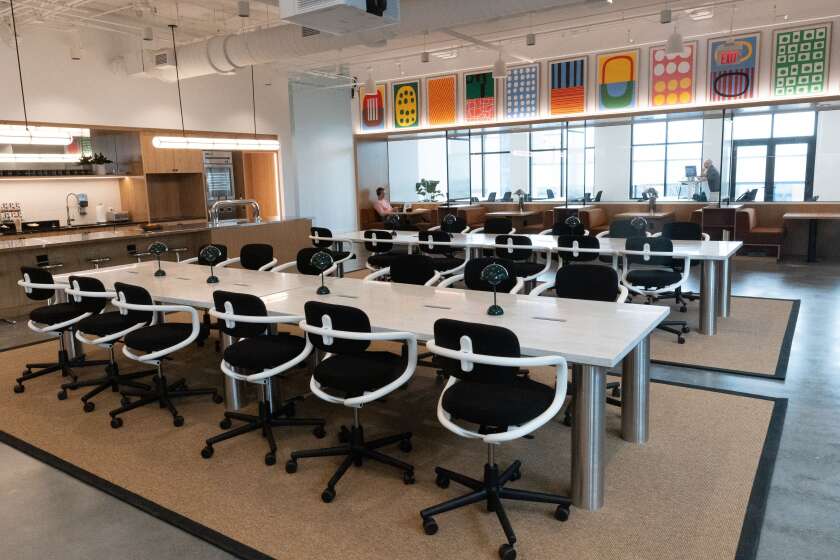
(Steve Schaefer/TNS)
In Brief:
WeWork, the brash company that provides flexible coworking space in commercial office buildings, drew billions of dollars in investments, based on the promise that it would disrupt the future of office work. Now, it seems there was more disruption than WeWork bargained for.
At one time, WeWork had market value as high as $47 billion, but last month the company filed for bankruptcy. Its stock is now worth well under 50 cents per share. But commercial real estate experts caution not to overinterpret WeWork’s bankruptcy as an indictment of its overall approach, or to overestimate the impact it will have on downtown office markets.
The company signed too many long-term leases with too few subtenants during its expansion in the run-up to the COVID-19 pandemic. As it goes through bankruptcy, the company will seek to renegotiate or cancel many of its leases, generating painful losses for many property owners. But eventually, it’s likely to come out the other side as a viable business, observers say. And the type of office space it specializes in — with flexible working spaces and shared amenities — is now a growing part of the portfolios of many of the biggest commercial landlords.
“Even if every single flexible office space ceased to exist, we would only have vacancy that rose by a marginal amount. That’s really important to keep in mind,” says Julie Whelan, who leads a global research team at CBRE, a commercial real estate firm.
For now, flexible office space is still a small portion of the overall market, on the order of 1.7 percent, Whelan says. With office vacancy already at record highs, one company’s bankruptcy — even one as big as WeWork — isn’t going to substantially alter the trajectory of the market, she says.
Not Too Big to Fail
“They were going direct to the consumer that probably would have never been in the market, [or] in a position to lease space to begin with,” Whelan says.
WeWork accounts for more than 1 percent of occupied office space in just five U.S. cities, according to the real estate firm JLL. Losses related to the company’s bankruptcy will be felt most keenly by its own investors and landlords, says Scott Homa, who leads property sectors research in the Americas for JLL. “It never rose to the level of creating systemic risk for the market,” Homa says. “It never got too big to fail.”
Even in the cities where it has the biggest footprint, WeWork controls only a small fraction of office space. The company occupies nearly 7 million square feet of space in New York, a higher proportion than any other city, according to JLL. Its footprint is most concentrated in the southern part of Midtown Manhattan, but even there it controls less than 5 percent of office space.

(Luiz C. Ribeiro for TNS)
Broader Market Changes
The pandemic created much broader and swifter changes to work habits than even WeWork was expecting. Office-centered urban neighborhoods are challenged from many directions. As New York tries to understand how hybrid work will change its various real estate markets, it’s hoping to diversify the types of properties that occupy Midtown South. In October, New York's Department of City Planning began holding meetings for a new Midtown South Mixed-Use Plan, focused on updating zoning rules to allow more housing and other uses in the area.
“Changing work patterns make this the right time to rethink Midtown South," says Joe Marvilli, a department spokesperson. "While the proposal’s still in its early stages, we aim to allow housing and income-restricted housing in this neighborhood while also supporting a robust commercial sector.”
More cities are looking to create layers of residential, retail, offices and entertainment in downtown districts, as those mixed-use developments tend to be more resilient and recover more quickly after downturns. Office vacancy is at a record high. It’s possible that, taking into account conversions of existing buildings to residential and other uses, the total square footage of office space could actually shrink next year, says Homa. That would be the first time ever.
Some of the biggest property owners in the world are increasingly adding flexible office space to their buildings, says CBRE's Whelan. Traditional space, customized for long-term tenants, is still the backbone of most commercial property portfolios, she says. But landlords are likely to continue adding space with more flexible designs, and shorter lease terms, as they adjust to changing demands.
WeWork helped accelerate those changes, Whelan says. Its bankruptcy isn’t likely to slow them down.
“It was obviously a huge event in the market for a company that was discussed so often in the market leading up to this, but I would say it is really important to separate the business model flaws from the overall fate of the market,” she says. “Ultimately, the flex market is going to continue to grow and strengthen and morph. We are now into a more mature flex environment that is going to last.”
Related Articles












